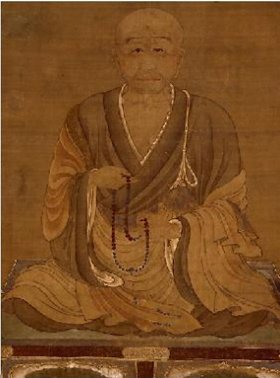|
Genshin
, also known as , was the most influential of a number of scholar-monks of the Buddhist Tendai sect active during the tenth and eleventh centuries in Japan. Genshin, who was trained in both esoteric and exoteric teachings, wrote a number of treatises pertaining to the increasingly popular Pure Land Buddhism from a Tendai viewpoint, but his magnum opus, the , had considerable influence on later Pure Land teachers such as Honen and Shinran. In spite of growing political tensions within the Tendai religious hierarchy, and despite being one of the two leading disciples of the controversial Ryogen, 18th head of the Enryakuji Temple, Genshin and a small group of fellow monks maintained a secluded community at Yokawa on Mount Hiei solely devoted toward rebirth in the Pure Land, while staying largely neutral in the conflict. He was one of the thinkers who maintained that the nembutsu ritual, which was said to induce a vision of Amida, was an important hermeneutic principle in the B ... [...More Info...] [...Related Items...] OR: [Wikipedia] [Google] [Baidu] |
ÅjÅyÅshÅ«
The was an influential medieval Buddhist text composed in 985 by the Japanese Buddhist monk Genshin. Three volumes in length and in kanbun prose, the text is a comprehensive analysis of Buddhist practices related to rebirth in the Pure Land of Amida Buddha, drawing upon earlier Buddhist texts from China, and sutras such as the Contemplation Sutra. Genshin advocated a collection of mutually supportive practices, such as sutra recitation, centered around visual meditation of Amitabha Buddha where later Pure Land sects favored an approach that relied on exclusive recitation of the verbal ''nembutsu''. The text is also well known for its graphic descriptions of the Hell realms, and sufferings one might endure for harmful acts committed in this life. Its influence can be seen in Japanese Buddhist paintings and other, later, texts. The founder of JÅdo ShinshÅ« Buddhism, Shinran, wrote an influential commentary on the ''ÅjÅyÅshÅ«'' titled, "Notes on Essentials of Rebirth", while ... [...More Info...] [...Related Items...] OR: [Wikipedia] [Google] [Baidu] |
Tendai
, also known as the Tendai Lotus School (天å°æ³è¯å® ''Tendai hokke shÅ«,'' sometimes just "''hokke shÅ«''") is a MahÄyÄna Buddhist tradition (with significant esoteric elements) officially established in Japan in 806 by the Japanese monk SaichÅ ( posthumously known as DengyÅ Daishi). The Tendai school, which has been based on Mount Hiei since its inception, rose to prominence during the Heian period (794-1185). It gradually eclipsed the powerful ''HossÅ'' school and competed with the rival Shingon school to become the most influential sect at the Imperial court. By the Kamakura period (1185-1333), Tendai had become one of the dominant forms of Japanese Buddhism, with numerous temples and vast landholdings. During the Kamakura period, various monks left Tendai (seeing it as corrupt) to establish their own "new" or "Kamakura" Buddhist schools such as JÅdo-shÅ«, Nichiren-shÅ« and SÅtÅ Zen. The destruction of the head temple of Enryaku-ji by Oda Nobunaga in 1 ... [...More Info...] [...Related Items...] OR: [Wikipedia] [Google] [Baidu] |
Pure Land Buddhism
Pure Land Buddhism (; ja, æµåä»æ, translit=JÅdo bukkyÅ; , also referred to as Amidism in English,) is a broad branch of Mahayana Buddhism focused on achieving rebirth in a Buddha's Buddha-field or Pure Land. It is one of the most widely practiced traditions of Buddhism in East Asia. According to Charles B. Jones "Pure Land is the dominant form of Buddhism in China, Japan and Korea."Jones, Charles B. (2021). ''Pure Land: History, Tradition, and Practice'', p. xii. Shambhala Publications, . In Chinese Buddhism, the tradition is sometimes called a zÅng (school) in an institutional sense, but historically it was most commonly described as a "dharma-gate" (fÇmén æ³é), referring to a method of Buddhist practice. In Japanese Buddhism, the term more commonly refers to specific institutions.Jones, Charles B. (2019) ''Chinese Pure Land Buddhism, Understanding a Tradition of Practice,'' pp. 10-12. University of Hawaiâi Press / Honolulu. In Tibetan Buddhism, prayers and ... [...More Info...] [...Related Items...] OR: [Wikipedia] [Google] [Baidu] |
Mount Hiei
is a mountain to the northeast of Kyoto, lying on the border between the Kyoto and Shiga Prefectures, Japan. The temple of Enryaku-ji, the first outpost of the Japanese Tendai (Chin. Tiantai) sect of Buddhism, was founded atop Mount Hiei by SaichÅ in 788 and rapidly grew into a sprawling complex of temples and buildings that were roughly divided into three areas: # The area near the summit, and technically in Kyoto Prefecture. # The area, also near the summit, where Enryaku-ji Temple was first founded, and located just within Shiga Prefecture. # The area near the northernmost end of Mount Hiei. Due to its remoteness, as a temple complex it experienced periods of revival and decline, starting with Ennin, later revived by RyÅgen and made famous by the scholar-monk Genshin. Due to its position north-east of the ancient capital of Kyoto, it was thought in ancient geomancy practices to be a protective bulwark against negative influences on the capital, which along wi ... [...More Info...] [...Related Items...] OR: [Wikipedia] [Google] [Baidu] |
Jimon And Sanmon
and , also known as the Enchin and Ennin factions, respectively, were rival branches of the Tendai sect of Buddhism created in the 9th century and based on Mount Hiei just outside Kyoto. Jimon's head temple was Mii-dera, at the foot of Mount Hiei, while the Sanmon sect was based at Enryaku-ji, at the summit of the mountain. The origins of the schism began with a rivalry between the lineages of two disciples of the founder of Tendai Buddhism, Saicho, named Ennin and Enchin, over who would be the of Enryaku-ji temple, rather than based on differing opinions on dogma or doctrine. Following the deaths of Enchin in 891, this rivalry only deepened, and by 923 the 18th abbot, RyÅgen, further enflamed this rivalry, as he sought to solidify the Ennin lineage's hold not just on Enryaku-ji, but as the sole representatives of the Tendai sect at the Imperial court. For example, in the Åwa Debate of 963, the Tendai side of the debate included RyÅgen and his close associates in t ... [...More Info...] [...Related Items...] OR: [Wikipedia] [Google] [Baidu] |
Enryakuji
is a Tendai monastery located on Mount Hiei in Åtsu, overlooking Kyoto. It was first founded in 788 during the early Heian period (794â1185) by SaichÅ (767–822), also known as DengyÅ Daishi, who introduced the Tendai sect of Mahayana Buddhism to Japan from China. The temple complex has undergone several reconstruction efforts since then, with the most significant (that of the main hall) taking place in 1642 under Tokugawa Iemitsu. Enryaku-ji is the headquarters of the Tendai sect and one of the most significant monasteries in Japanese history. As such, it is part of the UNESCO World Heritage Site " Historic Monuments of Ancient Kyoto (Kyoto, Uji and Otsu Cities)". The founders of JÅdo-shÅ«, JÅdo ShinshÅ«, SÅtÅ Zen, and Nichiren Buddhism all spent time at the monastery. Enryaku-ji is also the center for the practice of kaihÅgyÅ (aka the "marathon monks"). History With the support of Emperor Kanmu, the Buddhist monk SaichÅ ordained a hundred disciples in 807 ... [...More Info...] [...Related Items...] OR: [Wikipedia] [Google] [Baidu] |
Vajrayana
VajrayÄna ( sa, वà¤à¥à¤°à¤¯à¤¾à¤¨, "thunderbolt vehicle", "diamond vehicle", or "indestructible vehicle"), along with MantrayÄna, GuhyamantrayÄna, TantrayÄna, Secret Mantra, Tantric Buddhism, and Esoteric Buddhism, are names referring to Buddhist traditions associated with Tantra and "Secret Mantra", which developed in the medieval Indian subcontinent and spread to Tibet, Nepal, other Himalayan states, East Asia, and Mongolia. VajrayÄna practices are connected to specific lineages in Buddhism, through the teachings of lineage holders. Others might generally refer to texts as the Buddhist Tantras. It includes practices that make use of mantras, dharanis, mudras, mandalas and the visualization of deities and Buddhas. Traditional VajrayÄna sources say that the tantras and the lineage of VajrayÄna were taught by ÅÄkyamuni Buddha and other figures such as the bodhisattva Vajrapani and Padmasambhava. Contemporary historians of Buddhist studies meanwhile argue t ... [...More Info...] [...Related Items...] OR: [Wikipedia] [Google] [Baidu] |
Taira Clan
The Taira was one of the four most important clans that dominated Japanese politics during the Heian, Kamakura and Muromachi Periods of Japanese history â the others being the Fujiwara, the Tachibana, and the Minamoto. The clan is divided into four major groups, named after the emperor they descended from: Kanmu Heishi, NinmyÅ Heishi, Montoku Heishi, and KÅkÅ Heishi. The clan is commonly referred to as or , using the character's On'yomi for ''Taira'', while means " clan", and is used as a suffix for " extended family". History Along with the Minamoto, Taira was one of the honorary surnames given by the emperors of the Heian Period (794â1185 CE) to their children and grandchildren who were not considered eligible for the throne. The clan was founded when the Imperial Court grew too large, and the emperor ordered that the descendants of previous emperors from several generations ago would no longer be princes, but would instead be given noble surnames a ... [...More Info...] [...Related Items...] OR: [Wikipedia] [Google] [Baidu] |
Samadhi
''Samadhi'' (Pali and sa, समाधि), in Buddhism, Hinduism, Jainism, Sikhism and yogic schools, is a state of meditative consciousness. In Buddhism, it is the last of the eight elements of the Noble Eightfold Path. In the Ashtanga Yoga tradition, it is the eighth and final limb identified in the '' Yoga Sutras'' of Patanjali. In the oldest Buddhist suttas, on which several contemporary western Theravada teachers rely, it refers to the development of an investigative and luminous mind which is equanimous and mindful. In the yogic traditions, and the Buddhist commentarial tradition on which the Burmese Vipassana movement and the Thai Forest tradition rely, it is interpreted as a meditative absorption or trance, attained by the practice of '' dhyÄna''. Definitions ''Samadhi'' may refer to a broad range of states. A common understanding regards ''samadhi'' as meditative absorption: * Sarbacker: ''samÄdhi'' is meditative absorption or contemplation. * Diener, Erh ... [...More Info...] [...Related Items...] OR: [Wikipedia] [Google] [Baidu] |
Three Ages Of Buddhism
The Three Ages of Buddhism, also known as the Three Ages of the Dharma (), are three divisions of time following Shakyamuni Buddha's death and passing into Nirvana in East Asian Buddhism. Three Ages The Three Ages of Buddhism are three divisions of time following Buddha's passing: # Former Day of the Dharma â also known as the âAge of the Right Dharmaâ (; Japanese: shÅbÅ), the first thousand years (or 500 years) during which the Buddha's disciples are able to uphold the Buddha's teachings; # Middle Day of the Dharma â also known as the âAge of Semblance Dharmaâ (; Japanese: zÅhÅ), the second thousand years (or 500 years), which only resembles the right Dharma; # Latter Day of the Dharma â also known as âthe Degenerate Age of Dharmaâ (; Japanese: mappÅ), which is to last for 10,000 years during which the Dharma declines. In the Sutra of the Great Assembly (Sanskrit: ''Maha-Samnipata Sutra''; Japanese: ''Daijuku-kyÅ''), the three periods are further di ... [...More Info...] [...Related Items...] OR: [Wikipedia] [Google] [Baidu] |





_(8697431158).jpg)